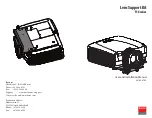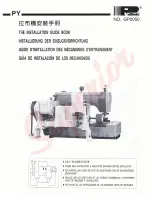
25
R&D activities for the fiscal year ended March 31, 2004
■
R&D Expenses
(Billion ¥)
■
Composition of FY2003 R&D Expenses
R&D expenses totaled ¥514.5 billion for
the fiscal year ended March 31, 2004,
which amounted to ¥71.4 billion, or 16%,
more than in the previous fiscal year. The
ratio of R&D expenses to sales, excluding
the Financial Services segment, rose from
6.4% to 7.5%.
R&D expenses in the Electronics segment
increased ¥49.1 billion, or 13%, to ¥429.4
billion, while in the Game segment R&D
expenses increased ¥21.9 billion, or 36%,
to ¥83.4 billion.
Within R&D expenses in the Electronics
segment, about 62% was allocated for
product prototype development and the
remaining 38% for new, mid- to long-
term technologies for semiconductors,
telecommunications, displays, next genera-
tion optical discs and other fields. In the
Game segment, R&D expenses were
mainly allotted for hardware, including
semiconductors and network technology,
and the creation of software.
Displays
Display technology has been a Sony core tech-
nology since the days of the CRT, when Sony
created its highly acclaimed Trinitron system.
Sony is developing next generation display
technologies for LCDs, organic electrolumines-
cence (OEL) and projectors to best match
differing market requirements in terms of
screen size and product category. One highly
advanced component is the Grating Light
Valve (GLV) projector, which uses high-output
lasers to produce the three primary colors.
Sony has also developed a Silicon X-tal Reflec-
tive Display (SXRD) projector that produces a
high-resolution 8.85 megapixel (4,096H x
2,160V), four times sharper than current
digital high-definition televisions. Development
work continues with the aim of delivering
solutions that achieve remarkable resolution
and color reproduction from content to dis-
plays, all with the unmistakable Sony touch.
Home Servers
Home servers are set to become important
fixtures in the home. As digital consumer elec-
tronics become increasingly linked through
networks, home servers will be needed to con-
trol both the operations of network appliances
and the flow of content. These servers are likely
to function as storage terminals, most likely in
the form of DVD or Blu-ray Disc recorders
equipped with hard disk drives, as well as con-
tent service and network portals. Possessing
many of the world’s most advanced technolo-
gies in both semiconductor lasers and optical
pickups, Sony is set to become the industry
leader in an emerging network server market
that demands expanded storage functionality
and high-speed transfer rates.
Long-term research fields
The shift from inorganic to organic materials
Inorganic materials, such as metals and silicon,
in addition to mechanical technologies, have
defined much of the technology of the past
century. But a new century has shifted the
spotlight to carbon-based and other organic
materials, as well as biomolecular emulation
technologies. Sony is targeting this shift
through its R&D activities with a mid- to long-
term perspective. The fiscal year ended March
31, 2004, witnessed the first step in this direc-
tion, namely, Sony’s announcement that it had
developed a tandem dye-sensitized solar cell
that employs a polymer gel electrolite and
nano-structured electrode. Currently, solar cells
are made of semiconductor materials, such as
silicon and gallium arsenide. Polymers have a
high energy conversion efficiency of 10.5%.
Moreover, they are inexpensive and enable the
easy creation of a large surface area. At the
time of announcement, this technology had the
highest conversion rate for its type in the world.
In the field of electronic components, Sony
unveiled an organic transistor in February 2004
at the Institute of Electrical and Electronics
Engineers International Solid-State Circuit
Conference (IEEE ISSCC), the world’s most
prestigious international conference for semi-
conductor ICs. The fruits of Sony’s research
shed light on the mechanism by which charged
carriers are injected from electrodes into the
organic semiconductor layer. This made possible
a new technology that improves the charge
carrier mobility of electrons within organic
transistors. Sony engineers were not only suc-
cessful in proving the operation of these
transistors, but also in utilizing them as the
driving transistor for an LCD that produces a
160 x 120 pixel image.
Sony’s wide-ranging technological expertise
in materials, analysis, circuitry and finished
products made these accomplishments possible.
Imitating living organisms and brain
functions
Sony is exploring sophisticated robotics and
computing technology to create robots even
more like living beings.
In December 2003, Sony announced the
world’s first humanoid robot with the ability to
run and jump. Over the mid- to long-term, Sony
plans to further refine these movements while
incorporating the latest advances in perception
technology, as well as utilizing networks so that
robots can acquire knowledge and learn about
their environment. Research continues with the
aim of making robots even more human-like to
the point where people do not tire of them even
after frequent and extended encounters.
Others
Game
Electronics
2001
2002
2003
(FY)
433.2
443.1
514.5
Electronics
83.5%
Game 16.2%
Others 0.3%
Total:
¥514.5
billion
















































